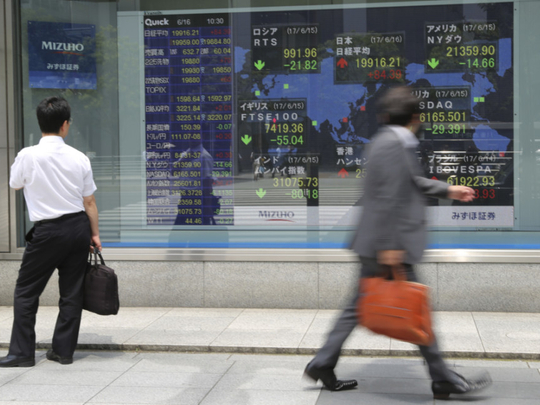
LONDON
World shares steadied on Friday after selling in the tech sector triggered their biggest fall in over a month, while the yen slid to a two-week low as the Bank of Japan signalled its stimulus was staying in place.
It was set to be the second week of falls for MSCI’s widely tracked world index, although Wall Street and Europe, which has been the star performer in the first half of the year, were trying to end it on an upnote.
London, Frankfurt and Paris climbed between 0.3 and 0.5 per cent, futures pointed to a stable restart for Apple and the like and euro the pound and the Swiss franc rose against the dollar in the currency market.
Greece’s 10-year government borrowing costs fell to their lowest since 2014 in bond markets as well, as Eurozone finance ministers and the International Monetary Fund approved a long-delayed 8.5 billion euro lifeline for Athens, albeit keeping them hanging on for debt relief.
“The things that we were worried about at the start of the year which were French elections and potentially a Greek deal not getting done, we have had all the good news on that now,” said State Street Global Markets’ strategist Michael Metcalfe.
He said the dollar’s rise for the week suggested markets had now priced in that positive news — France’s new President Emmanuel Macron is expected to get a parliamentary majority at the weekend too — and were thinking where to go next.
The Japanese yen hit a two-week low against the dollar after the Bank of Japan left its mass money printing programme unchanged, maintaining the contrast with the US Federal Reserve, which signalled further tightening this week.
It was trading 0.4 per cent lower at 111.35 yen per dollar, while the euro was buying $1.1170 compared with almost $1.13 earlier in the week.
The yen’s drop helped Japan’s Nikkei advance 0.7 per cent, narrowing its loss for the week to 0.3 per cent.
“The market was relieved that there was no mention of an exit strategy, at least for now,” said Yoshinori Shigemi, global market strategist at JPMorgan Asset Management.
Submerging markets
MSCI’s broadest index of Asia-Pacific shares outside Japan ended down roughly 0.85 per cent for the week though for emerging markets more broadly it was looking like being the worst week of the year so far.
Russian stocks steadied on Friday but have been hammered more than 4 per cent this week and the rouble is down for a third straight week, on talk of increased Western sanctions and as oil prices have stumbled back again.
The tech-heavy Nasdaq whose big names like Apple and Alphabet led Wall Street lower again on Thursday after more bearish analysts’ reports, pointed to a stabilisation in US trading rather than a rebound.
“Basically these stocks looks stretched. We have seen some really strong gains this year and we really haven’t seen a significant pull back,” said CMC Markets analyst Michael Hewson.
“If you look at a stocks like, Amazon they are trading 90 per cent above 200-week moving average. Sorry but that it just absurd.” US data also continues to come in mixed. US homebuilding fell to the lowest level in eight months figures showed ahead of the Wall Street restart, dampening the mood again after better-than-expected unemployment claims numbers and a survey on business conditions on Thursday.
Back in Europe, Britain’s sterling added almost 0.2 per cent to $1.2775 having jumped as high as $1.2795 the previous day after a Bank of England decision to kept UK rates at a record low was much closer than expected.
In commodities, oil remained subdued on continued worries over rising US gasoline inventories adding to already elevated global supply.
Global benchmarks Brent and US crude ticked up to $47.34 and $44.74 a barrel, on track for 2.4 and 2.8 per cent drops for the week respectively. It will also be their fourth consecutive week of falls.
The dollar’s strength kept gold flat at $1,255 an ounce, failing to make up Thursday’s 0.6 per cent drop. It is poised to close the week with a 1 per cent loss, its second weekly decline.












